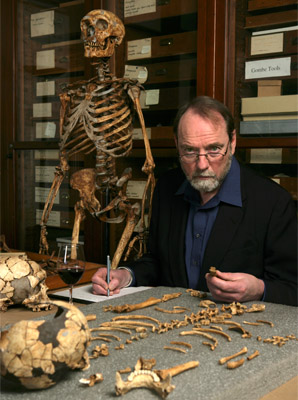Experts Guess: How Might Humans Change Over the Next 10,000 Years?
So much has changed in the past few thousand years that the past may not be a reliable guide to the future
Evolutionary biologist Nicholas R. Longrich thinks he knows how human beings will change in the next 10,000 years:
It’s hard to predict the future. The world will probably change in ways we can’t imagine. But we can make educated guesses. Paradoxically, the best way to predict the future is probably looking back at the past, and assuming past trends will continue going forward. This suggests some surprising things about our future.
We will likely live longer and become taller, as well as more lightly built. We’ll probably be less aggressive and more agreeable, but have smaller brains. A bit like a golden retriever, we’ll be friendly and jolly, but maybe not that interesting. At least, that’s one possible future.
Nicholas R. Longrich, “Future evolution: from looks to brains and personality, how will humans change in the next 10,000 years?” at The Conversation
Longrich goes on to explain his reasoning for all these suggestions in detail but the feature that might surprise many readers is the smaller brains. No one knows why but human brains have become smaller in recent millennia. He offers several suggestions:
It could be that fat and protein were scarce once we shifted to farming, making it more costly to grow and maintain large brains. Brains are also energetically expensive – they burn around 20% of our daily calories. In agricultural societies with frequent famine, a big brain might be a liability.
Maybe hunter-gatherer life was demanding in ways farming isn’t. In civilisation, you don’t need to outwit lions and antelopes, or memorise every fruit tree and watering hole within 1,000 square miles. Making and using bows and spears also requires fine motor control, coordination, the ability to track animals and trajectories — maybe the parts of our brains used for those things got smaller when we stopped hunting.
Or maybe living in a large society of specialists demands less brainpower than living in a tribe of generalists. Stone-age people mastered many skills – hunting, tracking, foraging for plants, making herbal medicines and poisons, crafting tools, waging war, making music and magic. Modern humans perform fewer, more specialised roles as part of vast social networks, exploiting division of labour. In a civilisation, we specialise on a trade, then rely on others for everything else.
Nicholas R. Longrich, “Future evolution: from looks to brains and personality, how will humans change in the next 10,000 years?” at The Conversation
Of course we don’t know any of this. All we know is that smaller brains have not prevented great advances that come from thinking. And it’s not clear that the past is a reliable guide. Jury is still out.
Here are some other ways experts have thought humans might change over the next few millennia:
At the BBC, Vandana Gupta thinks that technology will swamp any notion of evolution:
Our ability to alter birth rates and survival chances, through technology and medicine, is so powerful that it swamps the gentle tug of natural selection. Genetic engineering, cosmetic surgery and prosthetic implants will eventually reach the point where the shape of our bodies is as much a matter of fashion as the clothes we wear. And just like hemlines, there’s no final goal with this process, or even a single ideal… Much of this won’t be heritable change any more than making our children wear braces to straighten their teeth affects the genes they pass on to their children.
Vandana Gupta, “How might the human body evolve in the future?” at BBC Science Focus
At National Geographic, back in 2009, the views of scientists surveyed ranged from nothing much will happen through transhumanism will change everything:
“Since the advent of settled life, human populations have expanded enormously. Homo sapiens is densely packed across the Earth, and individuals are unprecedentedly mobile.
“In this situation, the fixation of any meaningful evolutionary novelties in the human population is highly improbable.” [anthropologist Ian] Tattersall said. “Human beings are just going to have to learn to live with themselves as they are.”
James Owen, “Future Humans: Four Ways We May, or May Not, Evolve” at National Geographic (November 24, 2009)
Alternatively, transhumanism will change everything, according to Nick Bostrom of the Future of Humanity Institute:
Transhumanism raises a spectacular array of possibilities, from supersoldiers and new breeds of athletes to immortal beings who, having had their brains scanned atom by atom, transfer their minds to computers.
In addition to living forever, “uploaded” beings would be able to “travel at the speed of light as an information pattern,” download themselves into robots for the occasional stroll through the real world, think faster when running on advanced operating systems, and cut their food budget down to zero, Bostrom imagines in his paper “The Transhumanist FAQ.” If that were to happen, a new type of evolution would emerge, Bostrom said.
James Owen, “Future Humans: Four Ways We May, or May Not, Evolve” at National Geographic (November 24, 2009)
Some suggestions sound rather strange but there is a logic to them:
According to paleoanthropologist Dr. Matthew Skinner from the University of Kent, humans will dramatically evolve to adjust to our changing planet. But depending on what direction humanity goes, these traits will vastly differ — and they all look bizarre.
Scenario #1: Water World
In this scenario, all ice has melted resulting in an unprecedented rise in sea-levels. This rise ultimately forces humans to adapt to an underwater world. In this world, humans become fishlike — developing artificial gills and transparent eyelids to help humans see underwater. Since humans will now have gills, lungs will not need to be as big, so our ribcages would shrink to reflect this. The transparent eye is something called a nictitating membrane — essentially a third eyelid which protects the eye in an underwater environment.
To help humans swim better, there may also be a lengthening of our fingers and toes which could cause us to evolve webbing in between them.
Joanne Kennell, “What Humans Might Look Like in the Future” at The Science Explorer (January 19, 2016)
Other scenarios Skinner suggests include increased body hair (if an ice age ensues) and opposable big toes (for manipulating things in the weightless environment of space.)
In short, no one really knows. But any one of these speculations would make an interesting sci-fi story premise.
You may also wish to read: Researchers still puzzled: Why did human brains shrink? Human brain volumes decreased by 10% in the last 40,000 years, coinciding with spectacular intellectual achievements. Examples of brain shrinkage among animals are fascinating but have not provided much insight. But perhaps we should ask, how much does brain size even matter?


